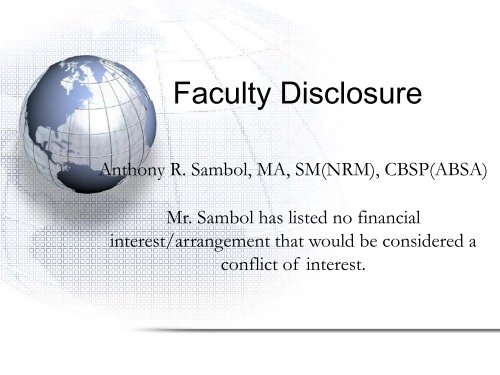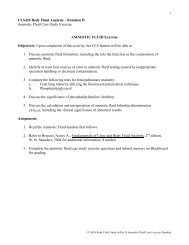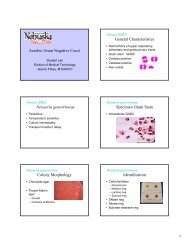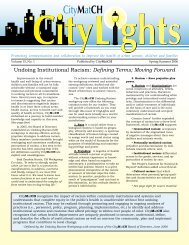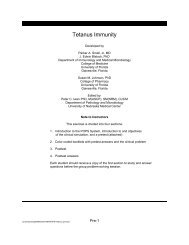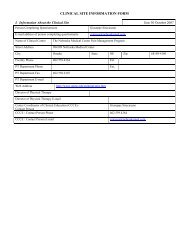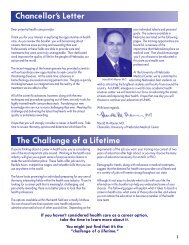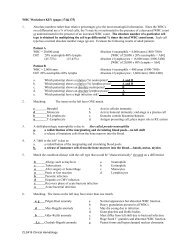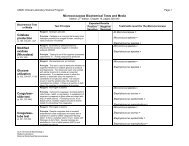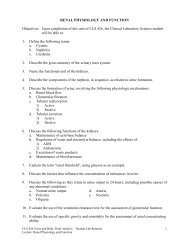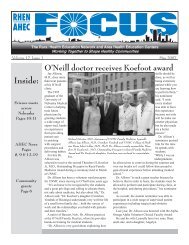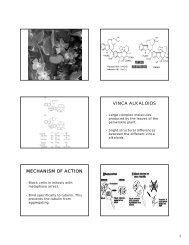Overview of the Nebraska Public Health Laboratory: - UNMC
Overview of the Nebraska Public Health Laboratory: - UNMC
Overview of the Nebraska Public Health Laboratory: - UNMC
Create successful ePaper yourself
Turn your PDF publications into a flip-book with our unique Google optimized e-Paper software.
Faculty Disclosure<br />
Anthony R. Sambol, MA, SM(NRM), CBSP(ABSA)<br />
Mr. Sambol has listed no financial<br />
interest/arrangement that would be considered a<br />
conflict <strong>of</strong> interest.
Anthrax,<br />
WNV,<br />
Salmonella,<br />
Mumps<br />
Influenza<br />
2
The NPHL<br />
Biosecurity Preparedness and<br />
Meeting O<strong>the</strong>r <strong>Public</strong> <strong>Health</strong> Needs:<br />
A Decade in Review<br />
Steven Hinrichs, MD, Director<br />
Pete Iwen, PhD, D(ABMM), Associate Director<br />
Paul Fey, PhD, Associate Director<br />
Tony Sambol, MA, Assistant Director
The NPHL is a cooperative partnership with<br />
<strong>the</strong> NE DHHS, <strong>the</strong> <strong>UNMC</strong>, <strong>the</strong> NMC.<br />
4
Mission Statement:<br />
“Dedicated to protecting <strong>the</strong> health<br />
and safety <strong>of</strong> <strong>Nebraska</strong>ns through<br />
diagnostic laboratory science,<br />
technology, and education.”<br />
5
Goals:<br />
Origins <strong>of</strong> <strong>UNMC</strong> project, est. 1997<br />
• To provide public health related laboratory testing within existing facilities for:<br />
• STD’s<br />
• Epidemiology support<br />
• Antibiotic resistance<br />
• Emerging infectious diseases<br />
• To develop an electronic reporting system<br />
• ELIRT<br />
6
What resources will be needed next?<br />
7
NLS-State Demonstration Projects, 2001<br />
Washington<br />
Minnesota<br />
Michigan<br />
<strong>Nebraska</strong>
Focus <strong>of</strong> Laboratories<br />
Differences<br />
“Provide information for decision making”<br />
Clinical <strong>Laboratory</strong>- NMC<br />
• Diagnostic testing<br />
• Some reference testing<br />
• Medical management<br />
• Focus = Individuals<br />
<strong>Public</strong> <strong>Health</strong> <strong>Laboratory</strong>- NPHL<br />
• Some diagnostic testing<br />
• Reference testing<br />
• Surveillance and monitoring<br />
• Focus = Populations<br />
Integrated Network<br />
Identifying <strong>Public</strong> <strong>Health</strong> Threats<br />
10
Barriers To Overcome<br />
Sustainability<br />
Geographic separation<br />
Resource limitations<br />
Mission differences<br />
Transport difficulties<br />
Non-culture methods<br />
Out-<strong>of</strong>-state laboratories<br />
Communication disparities
Developmental Process<br />
• Phase 1<br />
– Infrastructure and capability assessment<br />
– Establish relationships<br />
• Phase 2<br />
– Recruitment and training<br />
– Establish connectivity<br />
– Improve capability<br />
• Phase 3<br />
– Mature system<br />
– Integrate into <strong>the</strong> National <strong>Laboratory</strong> System
NPHL Specialized<br />
Sections:<br />
<strong>Laboratory</strong> preparedness<br />
for<br />
• Biological- Oct ‘99<br />
• Chemical<br />
• Radiological<br />
19
Biological Preparedness<br />
• Special Pathogens & Biosecurity Labs<br />
• Emerging infectious diseases<br />
• Monkey pox infection<br />
• SARS-Coronavirus<br />
• Avian Influenza A/H5N1<br />
• Novel Influenza A/H1N1<br />
• Tularemia-rabbit fever<br />
• Mumps<br />
• Salmonellosis<br />
• Histoplasmosis<br />
• E. coli O157:H7 infection<br />
• West Nile virus encephalitis<br />
– Biothreats<br />
• Anthrax<br />
• Plague<br />
20
Francisella tularensis<br />
Agents <strong>of</strong> Bioterrorism<br />
Brucella spp.<br />
Bacillus anthracis<br />
Yersinia pestis
CDC Category “A” Testing Capability<br />
Agent<br />
Bacillus anthracis<br />
Francisella tularensis<br />
Yersinia pestis<br />
Clostridium botulinum toxin<br />
Variola Major<br />
Disease<br />
Anthrax<br />
Rabbit fever<br />
Plague<br />
Botulism<br />
Smallpox*<br />
* NPHL is 1 <strong>of</strong> 26 CDC-approved labs in USA<br />
22
<strong>Laboratory</strong> Response Network (LRN)<br />
For Bioterrorism-CDC<br />
Level D Lab<br />
BSL-4<br />
Level C Lab<br />
BSL-3<br />
Level B Lab<br />
BSL-2 facility + BSL-3 Safety<br />
Practices<br />
Level-A Lab<br />
Use Class II Biosafety Cabinet<br />
No BSC; Limited ID Capacity<br />
Confirmatory Laboratories:<br />
D - Highest level characterization<br />
(Federal)<br />
C - Molecular assays,<br />
reference capacity<br />
B - Limited confirmation and<br />
transport<br />
A – “Rule-out” and “Refer”<br />
Basic Capacity<br />
NPHL<br />
Sentinel Laboratories:<br />
NPHL<br />
<strong>Nebraska</strong> <strong>Public</strong><br />
<strong>Health</strong> Lab
*3 8Level A<br />
Capable in NE<br />
86 Hospital Labs<br />
CDC Funded LRN for BT<br />
1999 Map<br />
2003:<br />
110+ Labs<br />
50 States<br />
Level A*<br />
Level B<br />
Level C
CDC’s <strong>Laboratory</strong> Response Network<br />
(LRN)<br />
25
LRN<br />
National Laboratories<br />
•Responsibilities<br />
•Specialized strain characterization<br />
•Bi<strong>of</strong>orencis<br />
•Select agent activity<br />
•Handling highly infectious biologics and<br />
toxic chemicals<br />
•CDC laboratories<br />
26
LRN<br />
Reference Laboratories<br />
•Responsibilities<br />
•Investigation and/or referral <strong>of</strong> specimens<br />
• Multiple labs<br />
•Local public health<br />
•Military<br />
•Federal<br />
•International<br />
•Australia, Canada, and UK<br />
•Multiple lab types<br />
•Veterinary<br />
•Agriculture<br />
•Food<br />
•Water<br />
27
LRN<br />
Sentinel Laboratories<br />
•Responsibilities<br />
•Provide routine diagnostic services<br />
•Rule-out and referral steps in <strong>the</strong><br />
identification process.<br />
28
Anthrax Bioterrorist Event<br />
Sep-Oct, 2001
Local BT events<br />
Lincoln Officials Await Results on Package<br />
Labeled “Anthrax” OWH 3/31/00<br />
33
Specimens submitted<br />
1Oct through 9Dec 2001<br />
Douglas County 49<br />
Lancaster County 43<br />
O<strong>the</strong>r Counties* 19<br />
* Counties included: Nemaha, Cherry, Madison,<br />
Buffalo, Cass, Colfax, Richardson, Washington, Saline,<br />
Dodge, Fillmore, Nance; Plymouth & Pottowatamie IA
NPHL Anthrax Testing<br />
Yr 2001<br />
Week :<br />
10/1 10/8 10/15 10/22 10/29 11/5 11/12 11/19 11/26 12/3 12/10 12/17<br />
NPHL<br />
<strong>Nebraska</strong> <strong>Public</strong><br />
<strong>Health</strong> Lab
June 2003<br />
• “Monkeypox sickens 20 people in USA”, USA Today<br />
• “…spread by pet prairie dogs in 15 states…exposed by a sick<br />
Gambian rat”<br />
37
Spring<br />
2003<br />
Tested<br />
specimens for<br />
SARS- associated<br />
Coronavirus
“It was an extremely odd year.”<br />
OWH 1-5-04<br />
41
Oct<br />
2005<br />
42
“What’s up {with <strong>the</strong> rabbits} Doc?”<br />
Facility Source Collected Agent<br />
BryanLGH Human 05/01/05 Francisella tularensis<br />
Children's Hospital Human 06/01/05 Francisella tularensis<br />
BryanLGH Human 06/17/05 Francisella tularensis<br />
Children's Hospital Human 07/13/05 Francisella tularensis<br />
Good Samaritan Hospital Human 07/18/05 Francisella tularensis<br />
BryanLGH Human 08/05/05 Francisella tularensis<br />
Alegent Core <strong>Laboratory</strong> Human 08/14/05 Francisella tularensis<br />
Vet Diagnostics <strong>Laboratory</strong> Animal 09/27/05 Francisella tularensis<br />
Vet Diagnostics <strong>Laboratory</strong> Animal 10/21/05 Francisella tularensis<br />
Saint Francis - Grand Island Human 12/19/05 Francisella tularensis<br />
Saint Francis - Grand Island Human 12/21/05 Francisella tularensis<br />
Saint Francis - Grand Island Human 04/29/06 Francisella tularensis<br />
43
Epidemiological support-<br />
Norovirus Testing<br />
OWH Oct. 2005<br />
Joint effort : Molecular Diagnostics & Special<br />
Pathogens Laboratories<br />
44
National Foodborne Disease<br />
Surveillance<br />
48
Alfalfa Sprouts Salmonella<br />
isolates- PFGE 2October 2009<br />
PFGE-XbaI<br />
E2009006567<br />
E2009006877<br />
E2009006882<br />
NPHL10626<br />
. 10561<br />
. 10559<br />
. 10567<br />
.<br />
Saintpaul<br />
Saintpaul<br />
Saintpaul<br />
Typhimurium
NPHL Specialized<br />
Sections<br />
<strong>Laboratory</strong><br />
preparedness for<br />
• Biological- 1999<br />
• Chemical-2004<br />
• Radiological<br />
50
July 2003<br />
51
LRN Chemical Lab Preparedness: 1999<br />
Level 1 Labs (5)<br />
No Capacity (45)<br />
52
Chemical Lab Preparedness: 2005<br />
53
LRN Chemical Testing Capability:<br />
CDC<br />
1 lab<br />
Level 1<br />
10 labs<br />
Level 2<br />
48 labs<br />
Level 3<br />
62 labs<br />
•Level 1+2+3 Activities<br />
•Mustards<br />
•Nerve Agents<br />
•Level 2+3 Activities<br />
•Cyanide<br />
•Toxic Metals<br />
•Competency in<br />
Collection &<br />
Shipment <strong>of</strong><br />
Clinical Samples<br />
•Comprehensive<br />
Response Plan
Chemical Terrorism Preparedness Lab<br />
Agilent GC/MSD: Cyanide Detection
“Omaha Traffic Accident Takes Toxic Turn”<br />
OWH, 8/23/04<br />
…identified <strong>the</strong> chemical as cyanuric chloride…<br />
56
Environmental Testing in <strong>the</strong> Field<br />
• SENSIR Technologies<br />
– HAZMATID<br />
• Field unit capable <strong>of</strong> going<br />
into “hot zone”<br />
• Unit can be decontaminated<br />
– Submersible<br />
57
Test Environmental Samples<br />
• Infrared Spectrometry<br />
• Locations<br />
– UNK<br />
– UNL<br />
– <strong>UNMC</strong><br />
• Support HazMat Field<br />
Systems<br />
• Unknowns<br />
– Solids<br />
– Liquids<br />
– Pastes<br />
58
Infrared Spectrometry<br />
• Sealable microscope<br />
slides<br />
59
NPHL Specialized<br />
Sections:<br />
<strong>Laboratory</strong><br />
preparedness for<br />
• Biological- 1999<br />
• Chemical-2004<br />
• Radiological-2010<br />
60
Monday, June 10, 2002<br />
Dirty bomb's biggest<br />
hazard would be<br />
panic<br />
By H. JOSEF HEBERT--<br />
The Associated Press
Connectivity in <strong>Nebraska</strong><br />
We have come a long ways……
Hospital Laboratories in <strong>Nebraska</strong> with Computer Connectivity<br />
5<br />
88<br />
Hospitals<br />
93<br />
Counties<br />
45<br />
2001 (23) 2002<br />
(51)<br />
2004<br />
(80)<br />
91% Hospital Laboratories have Connectivity in 2004<br />
Fax Only 2004 (8)
State <strong>of</strong> <strong>Nebraska</strong><br />
CONAPS To CORENAPS Network<br />
Keya Paha Boyd<br />
Sioux<br />
Dawes Sheridan<br />
Holt Knox Cedar<br />
Cherry<br />
Rock<br />
Dixon<br />
Dakota<br />
Box Butte<br />
Pierce<br />
Brown<br />
Wayne<br />
Antelope<br />
Thurston<br />
Grant HookerThomas<br />
Scottsbluff<br />
Blaine<br />
Loup<br />
Garfield<br />
Wheeler 1<br />
Morrill<br />
Stanton Burt<br />
7<br />
Madison Cuming<br />
Garden<br />
Boone<br />
Dodge<br />
Banner<br />
Arthur<br />
McPherson Logan<br />
Valley<br />
Platte<br />
Greeley<br />
Colfax Washington<br />
Nance<br />
Cheyenne<br />
Custer Howard<br />
Kimball<br />
Keith<br />
Butler Douglas<br />
6<br />
Lincoln<br />
Sherman Merrick<br />
2<br />
Deuel<br />
Polk<br />
Saunders Sarpy<br />
5<br />
Dawson Buffalo Hall York Seward Cass<br />
Perkins<br />
4 Hamilton Lancaster<br />
Chase<br />
Kearney<br />
Saline 3<br />
Hayes Frontier Phelps<br />
Otoe<br />
Gosper AdamsClay<br />
Fillmore JohnsonNemaha<br />
Dundy<br />
Franklin<br />
Red<br />
Gage<br />
Hitchcock FurnasHarlan<br />
Nuckolls Jefferson Richardson<br />
Willow<br />
Webster Thayer Pawnee<br />
CORENAP Locations<br />
1) Norfolk<br />
2) Omaha<br />
3) Lincoln<br />
4) Grand Island<br />
5) North Platte<br />
6) Sidney<br />
7) Scotts Bluff<br />
#<br />
= CONAPs<br />
= CORENAP<br />
= STATE BACKBONE<br />
= Qwest ?<br />
= Sprint ?<br />
= Alltel ?
STATPack<br />
Secure<br />
Telecommunications<br />
Application<br />
Terminal<br />
Package<br />
NPHL/<strong>UNMC</strong> & UNO Peter Kiewit Institute<br />
68
STATPack Prototype Unit, ca 2004
STATPack TM Today<br />
70
Scottsbluff<br />
Alliance<br />
Bridgeport<br />
Valentine<br />
North Platte<br />
Lexington<br />
Imperial Grant<br />
Imperial<br />
McCook<br />
Benkelman<br />
Kearney<br />
Holdrege<br />
O’Neill Osmond Wayne<br />
Winnebago<br />
Pender<br />
Albion<br />
West Point<br />
Norfolk<br />
Grand Island<br />
Minden<br />
Hastings<br />
Red Cloud<br />
Blair<br />
Columbus<br />
Fremont<br />
Seward<br />
Papillion<br />
Lincoln(4)<br />
York Lincoln(1)<br />
Auburn<br />
Beatrice<br />
Omaha(8)<br />
Omaha(4)<br />
Bellevue<br />
<strong>Nebraska</strong> City
New Partnerships<br />
Formed<br />
73
NPHL Partners<br />
• <strong>Nebraska</strong> 72 nd CST<br />
• HazMat teams<br />
• First responders<br />
• Local, state, and federal law<br />
enforcement<br />
• FBI<br />
• EPA<br />
• NDEQ<br />
• NSP<br />
• NE Regional Poison Control Center<br />
• Emergency medical personnel &<br />
hospitals<br />
• Medical toxicologists<br />
• And many more<br />
74
Weapons <strong>of</strong> Mass Destruction<br />
Civil Support Team<br />
OPERATION ROLLING THUNDER<br />
Bellevue, <strong>Nebraska</strong><br />
14 – 18 Jun 2010
<strong>Laboratory</strong> Training<br />
• Building <strong>the</strong> NLN<br />
• Visited 88 laboratories<br />
• Traveled 6,017 miles<br />
• Completed Lab assessment survey<br />
– What do laboratorians wanted from <strong>the</strong> STC?<br />
• Goal<br />
– Get “buy-in” for what NPHL is trying to do
Preparedness Workshops<br />
• CT laboratory preparedness training<br />
• 11 facilities<br />
• 16 with MOU<br />
• PCC in June<br />
• Mobile labeling/ordering solution<br />
• Special pathogens wet workshop<br />
• To date (starting May 2004)<br />
• 112 have attended representing 38 <strong>of</strong> 45 sentinel labs<br />
• O<strong>the</strong>r states have attended, taught in KS
In summary…..<br />
79
Incident<br />
Local Response<br />
State Assets Requested:<br />
NEMA, CST, NPHL, NDEQ,<br />
NHHSS<br />
CDC Sends Results<br />
to State<br />
LRN Members Perform<br />
Level-Specific Duties<br />
and Report Results<br />
Back to CDC<br />
State Requests<br />
NPHL &<br />
CDC Assistance<br />
CDC Contacts<br />
LRN Members<br />
NPHL & CDC<br />
Rapid<br />
Response<br />
Team Deploys<br />
CDC<br />
Conducts<br />
Rapid<br />
Toxic<br />
Screen<br />
CDC Sends Results<br />
to State
Towards <strong>the</strong> Future………………
Questions or Comments?<br />
www.nphl.org<br />
84


